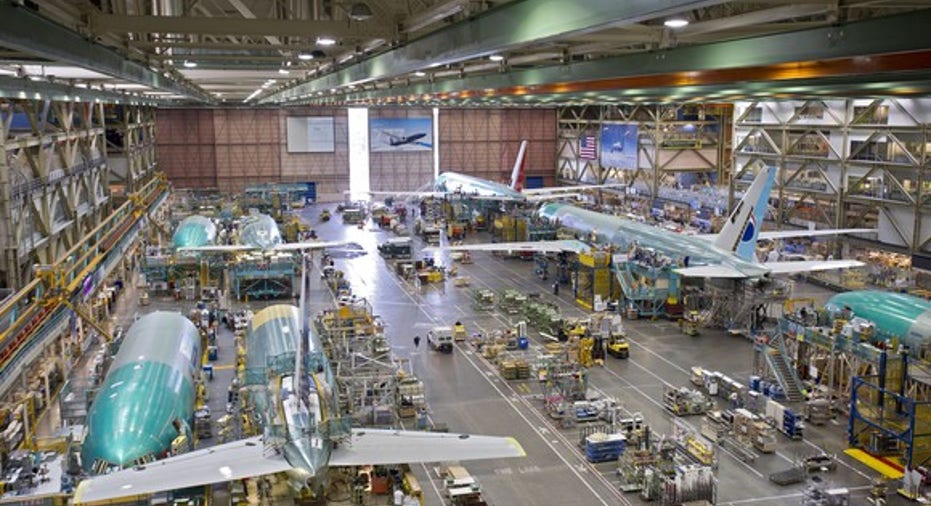Boeing's Rising Cash Flow Story Is Intact

In recent years, Boeing (NYSE: BA) has touted its rising cash flow to investors as a key factor that will drive its stock price higher over time. Most Wall Street analysts seem to buy into that story -- at least somewhat. A majority of the analysts following Boeing stock give it a buy rating (or the equivalent), while the average price target is more than 10% ahead of the current stock price.
However, a vocal minority of Boeing analysts are skeptical. For example, analysts at Bank of America Merrill Lynch, Goldman Sachs, and RBC Capital Markets have all theorized that Boeing's cash flow is headed down, not up.
Boeing does face significant challenges on the horizon. Nevertheless, these dour forecasts are too pessimistic. Rising production of the stalwart 737 and the improving profitability of the 787 Dreamliner will drive cash flow higher over the next several years.
Steady growth for the 737
Boeing has a massive backlog of more than 4,300 orders for its 737 jet. Today, it is building 42 per month -- about 500 per year -- but Boeing plans to accelerate production to 47 per month in 2017, 52 per month in 2018, and 57 per month in 2019. Even at that increased rate, Boeing would have enough orders to support more than six years of production.
Boeing is boosting 737 production to meet strong demand. Image source: Boeing.
Increasing 737 production should drive steady cash flow growth over the next few years. During this period, Boeing will also transition from building the current-generation 737 to producing the more fuel-efficient 737 MAX. That should also be positive for profitability and cash flow.
All told, cash flow from the 737 program (before taxes) could rise by about $2 billion from 2016 to 2020.
The 787 will become a cash cow
An even bigger source of cash flow growth is the 787. Cash flow for the Boeing 787 Dreamliner program is likely to be slightly better than breakeven for 2016. However, annual Dreamliner program profitability has been rising by nearly $2 billion a year recently.
Program profitability will continue increasing, driven by improved pricing, a mix shift toward more profitable models, step-downs in supplier pricing, and Boeing's own cost-cutting efforts. Most of the projected improvements are covered by firm contracts -- they aren't just the product of unrealistic assumptions by Boeing managers.
Boeing expects to recover more than $31 billion of deferred costs for the 787 program over the next six years. That means producing more than $31 billion of pre-tax cash flow during that period.
Most Boeing bears doubt that that Dreamliner profitability will improve so dramatically. But even if Boeing's targets are too aggressive, the 787 program should be able to churn out at least $5 billion of pre-tax cash flow annually by 2020, up from less than $1 billion in 2016.
Looking across the rest of Boeing
Aside from the 737 and 787 programs, it's likely that Boeing's cash flow will decline over the next few years. The defense business is relatively stable, particularly now that new orders from the Middle East will allow Boeing to keep producing fighter jets into the 2020s. However, the defense business isn't likely to post meaningful growth in the foreseeable future.
As for Boeing's other commercial programs, rising production of the venerable 767 -- largely to supply airframes for the KC-46 Pegasus military tanker -- will offset the financial drag from the 747 jumbo-jet program, which faces plummeting demand. On the other hand, the upcoming 777 model transition does represent a significant cash flow headwind.
Falling 777 production represents a major cash flow headwind for Boeing. Image source: Boeing.
Right now, the 777 is a huge cash cow, driving a disproportionate amount of Boeing's profit. On a pre-tax basis, the 777 could produce as much as $4 billion in cash flow this year.
Boeing will slash 777 production by more than 15% next year. By 2018, actual delivery rates will fall by a third, as Boeing starts building the upgraded 777X on the same assembly line. Those 777Xs aren't scheduled for delivery until 2020 and beyond.
Between the slowdown in deliveries and the costs of introducing the 777X, the 777 program's cash flow will fall by more than half by 2018. It will start to recover in 2020, though, with the pace of improvement depending largely on whether Boeing runs into unexpected trouble with building the 777X.
Plenty of room for cash flow growth
Even though the 777 program's cash flow is going to plummet over the next two years, Boeing is still on pace for significant cash flow growth between now and 2019. Simply put, rising cash flow from the 737 and 787 programs will more than offset the headwind from the 777.
Looking to 2020 and beyond, Boeing's cash flow could rise further, as the 737 and 787 will continue to churn out strong cash flow while 777 cash profitability will start to recover.
Boeing intends to return virtually all of its free cash flow to its shareholders. As investors reap the reward of Boeing's rising cash flow, Boeing shares are likely to move much higher.
A secret billion-dollar stock opportunity The world's biggest tech company forgot to show you something, but a few Wall Street analysts and the Fool didn't miss a beat: There's a small company that's powering their brand-new gadgets and the coming revolution in technology. And we think its stock price has nearly unlimited room to run for early in-the-know investors! To be one of them, just click here.
Adam Levine-Weinberg owns shares of Boeing. The Motley Fool recommends Bank of America. Try any of our Foolish newsletter services free for 30 days. We Fools may not all hold the same opinions, but we all believe that considering a diverse range of insights makes us better investors. The Motley Fool has a disclosure policy.



















